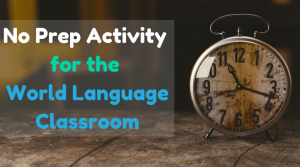Triangle Talk/Triángulo de Tertulia
 This is not only a great speaking activity for world languages, but also a student-led activity. The first time I did it this year, the students were scared, but they grew to love it and it became almost a weekly occurrence in the classroom. By the end of the year, students said that their speaking improved tremendously due to this exercise.
I call it Triangle Talk. Triangle is my creation so it pairs well with Tertulia-- the art of chatting in Spanish. However, I am sure you can call it any geometric shape you want. Conversation Circle? Rhombus Rap? Small Talk Square? You can work it out in your language of choice! The idea is to arrange the chairs/desks in that shape to allow for open discussion.
This is not only a great speaking activity for world languages, but also a student-led activity. The first time I did it this year, the students were scared, but they grew to love it and it became almost a weekly occurrence in the classroom. By the end of the year, students said that their speaking improved tremendously due to this exercise.
I call it Triangle Talk. Triangle is my creation so it pairs well with Tertulia-- the art of chatting in Spanish. However, I am sure you can call it any geometric shape you want. Conversation Circle? Rhombus Rap? Small Talk Square? You can work it out in your language of choice! The idea is to arrange the chairs/desks in that shape to allow for open discussion.
Pre-Activity
I make a worksheet to pass out to students. On this, there should be a space for a name, date, goals, topic, 5 questions (to eventually be written by the students) a checklist, a grading scale, and self-assessment. See below for checklist and self-assessment. I create this in the target language...but do what works best for your students.
- Pass out the worksheet and tell them what the topic/theme is. Mention whether if this is a formative or summative activity. You can decide! This usually involves the current unit of vocabulary and/or grammar topics. They fill in the topic in the appropriate space.
- Give the students 5-10 minutes to create 3-5 questions to ask during discussion. Set parameters-- Are yes and no questions ok? Are certain topics off limits? Be mindful of the age and skill set of your students.
- Then, have them fill out a space on the form where they write down how many times they want to participate that day. They can keep track of their individual participation by writing down hash marks. Sometimes I keep track of each student as well.
Today, I want to participate _____________ times.
During the Activity
Throughout the activity, students ask and answer questions in the group. Keep it student-led. Try not to engage in the conversation. Observe. Take mental and written notes. Interject a comment or rephrase a question if comprehensibility is compromised, or if absolutely necessary, model an appropriate answer. I also encourage them to use rejoinders such as “How interesting!” “What a pain!” or “What do you think?” You can post these around the room, on the board, or provide a handout.
They are usually quite polite; this activity can work without students raising hands. Students take turns--thus modeling a true conversation. To avoid rapid-firing questions and answers, I sometimes make a rule that a question needs to be answered at least three times before moving on to the next one. If you have a large class and are monitoring 2 groups, I keep them on their toes by circling the room. Students never know which group I am listening to! This activity can take as long as you wish… just be mindful of where your students are at and what they can sustain.
Wrapping it up
Student Self-Assessment
At the end of the activity, students self-assess themselves by checking off one of the two options:
Today I met my goal. ___________ yes not yet ___________.
Then, students grade themselves in these categories by circling a number on a scale from 1-5 for the following categories. A score of 5 is high, and 1 is low. After trial and error, these are the categories that work for me and my students:
Pronunciation: 5 4 3 2 1
Participation: 5 4 3 2 1
Grammar: 5 4 3 2 1
Enthusiasm: 5 4 3 2 1
Vocabulary: 5 4 3 2 1
Initiative: 5 4 3 2 1
Additionally, they need to check off any of the following that apply to them:
_____ I used new vocabulary.
_____ I used vocabulary from previous units of study.
_____ I spoke more than ( # ) times.
_____ I invited other students to participate.
_____ I did not speak English.
_____ I used complete sentences whenever possible/appropriate.
_____ I waited my turn.
_____ I listened well.
_____ I stayed on topic.
You can decide what rules work for you. If you have a large class, you may wish to break it up into 2 groups. I have used this with a group as large as thirty students. With these larger groups, you could have students ask questions one at a time by going around in a circle.

Teacher Assessment
At the end of the activity, students hand in their sheets. I grade them in the categories 1-5. Then, I take their total out of 30 and my total out of 30 and divide by 2. That is their grade! What I have found is that students are usually hard graders on themselves. I may write a small comment in the gradebook or on the actual paper if I feel it is needed. Sometimes I don’t even grade it and go with just the students’ self-evaluation. I evaluate a different way as well...see the end of the post!
I also use this method for the final exam, but in smaller groups-- usually four or five. Students have grown accustomed to the format throughout the whole year and are comfortable participating. I hated assigning a review packet to the class while I pulled individual students into the hall. I would have to come in and “Shhh!” the students every few minutes. It was draining and I was nagging. It made the end of the year take a downturn, and I felt like all I did was scold the last few class periods of the year.
For young students, writing questions is difficult. You may hear a lot of yes and no questions and answers. And that’s ok! Novice learners might give one-word answers or small phrases. Advanced students are expected to ask more open-ended questions, thus eliciting more of an opinion, richer vocabulary, and specific grammar concepts.
Here are some examples:
-Family members
-Favorite activities
-Class schedule
-Past tense and imperfect tense
-Subjunctive: I have students come up with 5 fake problems in order to receive
Advice and/or suggestions
-Environmental issues
-Travel
-Etc.!
Shy students? Approach them individually before or after class and encourage them to participate. Remind them that the less they participate, the fewer opportunities you have to assess them and are only able to evaluate them on what they offer. I have found that those students usually come around, growing in confidence by the end of the year.
If you are overwhelmed by grading so many categories, you can grade just 1 or 2 categories such as pronunciation and initiative if you are short on time. It will just count for fewer points. Sometimes I tell the students which categories and other times I don’t. If you are overwhelmed by making a worksheet, click here to see a PDF version of the one I use.
This activity is very flexible and can be used at any level.
Enter...Extempore!
After most Triangle Talks, I use Extempore as a culminating speaking activity. What I usually do is tell students that the assignment will be posted by the end of the day or by a certain time. I review the Triangle Talk as a whole and pick out questions that were repeated or aligned with a certain theme. As with other speaking activities I have discussed in previous blogs, students are already familiar with the topic(s) and able to produce chunks of sentences to repeat in an impromptu, unrehearsed situation in Extempore.
 Have fun exploring this activity!
Have fun exploring this activity!
This post is courtesy of Andrea Nazelli who is the Spanish department chair and teacher at Detroit Country Day School. Want more activity ideas? See her previous post
Keeping Students in the Target Language [Three Classroom Activities].

 This is not only a great speaking activity for world languages, but also a student-led activity. The first time I did it this year, the students were scared, but they grew to love it and it became almost a weekly occurrence in the classroom. By the end of the year, students said that their speaking improved tremendously due to this exercise.
I call it Triangle Talk. Triangle is my creation so it pairs well with Tertulia-- the art of chatting in Spanish. However, I am sure you can call it any geometric shape you want. Conversation Circle? Rhombus Rap? Small Talk Square? You can work it out in your language of choice! The idea is to arrange the chairs/desks in that shape to allow for open discussion.
This is not only a great speaking activity for world languages, but also a student-led activity. The first time I did it this year, the students were scared, but they grew to love it and it became almost a weekly occurrence in the classroom. By the end of the year, students said that their speaking improved tremendously due to this exercise.
I call it Triangle Talk. Triangle is my creation so it pairs well with Tertulia-- the art of chatting in Spanish. However, I am sure you can call it any geometric shape you want. Conversation Circle? Rhombus Rap? Small Talk Square? You can work it out in your language of choice! The idea is to arrange the chairs/desks in that shape to allow for open discussion.

 Have fun exploring this activity!
This post is courtesy of Andrea Nazelli who is the Spanish department chair and teacher at Detroit Country Day School. Want more activity ideas? See her previous post Keeping Students in the Target Language [Three Classroom Activities].
Have fun exploring this activity!
This post is courtesy of Andrea Nazelli who is the Spanish department chair and teacher at Detroit Country Day School. Want more activity ideas? See her previous post Keeping Students in the Target Language [Three Classroom Activities].


